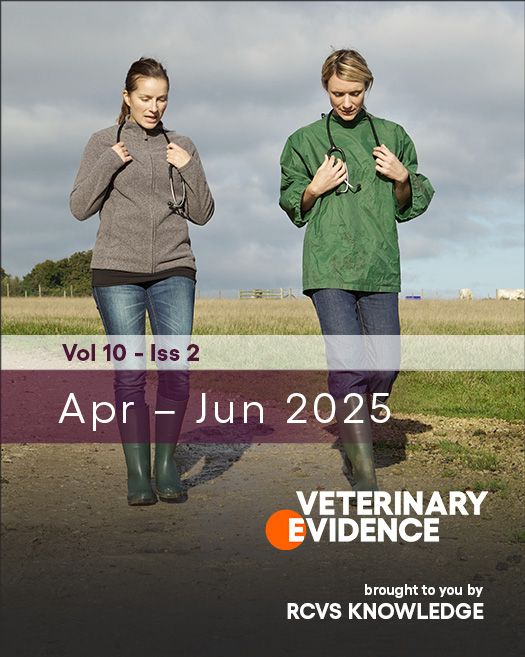DOI
https://doi.org/10.18849/ve.v10i2.705Abstract
Aims and objectives: The aim of this process audit was to assess if pain assessment in hospitalised canine ophthalmology patients was being documented and if found to be undocumented, implementing changes to improve this.
Background: Pain scoring anecdotally appeared to be recorded less in ophthalmology patients than in other patients in the practice. This was of particular concern to veterinary staff working out of hours shifts who rely on hospital records to monitor changes in patient condition. The target was for all patients to have a pain assessment recorded.
Methods: The records of 30 patients were analysed to find out how many had a pain score chart completed when requested or if they had any notes regarding pain assessment recorded on their hospital sheet.
Results: The initial audit data collected confirmed the suspicion that pain scoring was not adequately recorded in hospitalised canine ophthalmology patients, with 57% of patients having no pain assessment recorded.
Implementation of changes (team discussion & changes made) and re-audit: One month after implementing interventions that required staff to record signs of ocular pain on the patients hospital sheet, and the development of a mnemonic to remind staff of these signs and as the placement of reminder signs in prominent areas, a re-audit was performed. This showed significant improvement; 96% of patients had a pain assessment recorded.
Application: Performing this clinical audit enabled the practice to identify an area where improvements needed to be made. The team collaborated to devise a set of interventions they felt would address this issue improved the recording of pain assessment in this practice. This has allowed staff on differing shifts to recognise changes promptly and ultimately improve the wellbeing of patients. Other practices may find the interventions useful and wish to perform a similar audit.
References
Bloor, C. & Allan, L. (2017). Pain scoring systems in the canine and feline patient. The Veterinary Nurse. 8(5), 252–258. DOI: https://doi.org/10.12968/vetn.2017.8.5.252
Clark, J.S., Bentley, E. & Smith, L.J. (2011). Evaluation of topical nalbuphine or oral tramadol as analgesics for corneal pain in dogs: a pilot study. Veterinary Ophthalmology. 14(6), 358–364. DOI: https://doi.org/10.1111/j.1463-5224.2011.00883.x
Crompton, S. (2010). Pain assessment and pain scoring models: a review. The Veterinary Nurse. 1(1), 22–27. DOI: https://doi.org/10.12968/vetn.2010.1.1.22
Foote, A. (2021). Evaluation of acute and chronic ophthalmic pain. Veterinary Nursing Journal. 36(8), 238–243. DOI: https://doi.org/10.1080/17415349.2021.1905574
Gruen, M.E., Lascelles, B.D.X., Colleran, E., Gottlieb, A., Johnson, J., Lotsikas, P., Marcellin-Little, D. and Wright, B. (2022). 2022 AAHA Pain Management Guidelines for Dogs and Cats. Journal of the American Animal Hospital Association. 58(2), 55–76. DOI: https://doi.org/10.5326/JAAHA-MS-7292
Hernandez-Avalos, I., Mota-Rojas, D., Mora-Medina, P., Martínez-Burnes, J., Casas Alvarado, A., Verduzco-Mendoza, A., Lezama-García, K. & Olmos-Hernandez, A. (2019). Review of different methods used for clinical recognition and assessment of pain in dogs and cats. International Journal of Veterinary Science and Medicine. 7(1), 43–54. https://doi.org/10.1080/23144599.2019.1680044
Hunt, J. (2014). Pain assessment in small animal practice. Companion Animal. 19(3), 125–129. DOI: https://doi.org/10.12968/coan.2014.19.3.125
Knott, T. (2020). Ophthalmology for RVNs. The Veterinary Nurse. 11(2), 56–59. DOI: https://doi.org/10.12968/vetn.2020.11.2.56
Lee, L. & Yon, E. (2021). Pain management and intraocular pressure monitoring following phacoemulsification. The Veterinary Nurse. 12(10), 478–482. DOI: https://doi.org/10.12968/vetn.2021.12.10.478
Ortolani, F., Scilimati, N., Gialletti, R., Menchetti, L. & Nannarone, S. (2021). Development and preliminary validation of a pain scale for ophthalmic pain in horses: The Equine Ophthalmic Pain Scale (EOPS). The Veterinary Journal. 278, 105774. DOI: https://doi.org/10.1016/j.tvjl.2021.105774
Park, S.A., Park, Y.W., Son, W.G., Kim, T.H., Ahn, J.S., Ahn, J.T., Kim, S.E., Lee, I. & Seo, K. (2010). Evaluation of the analgesic effect of intracameral lidocaine hydrochloride injection on intraoperative and postoperative pain in healthy dogs undergoing phacoemulsification. American Journal of Veterinary Research. 71(2), 216–222. DOI: https://doi.org/10.2460/ajvr.71.2.216
RCVS. (2012). Cracking the codes. RCVS News. Available at: https://www.rcvs.org.uk/news-and-views/publications/rcvs-news-march-2012/ [Accessed 30 March 2025]
RCVS. (2015). Know your Code: Veterinary nursing and clinical governance. Veterinary Nursing Journal. 30(1), 9. DOI: https://doi.org/10.1080/17415349.2014.990243
RCVS. (2020). 6. Clinical governance [Code of Professional Conduct for Veterinary Nurses: Supporting guidance, Section 6]. Availiable at: https://www.rcvs.org.uk/setting-standards/advice-and-guidance/code-of-professional-conduct-for-veterinary-nurses/supporting-guidance/clinical-governance/ [Accessed 07 December 2023].
RCVS. (2023). CPD Policy and Guidance for VNs. Available at: https://www.rcvs.org.uk/document-library/cpd-policy-for-vns/ [Accessed 30 March 2025]
RCVS Knowledge. (2023). Clinical Audit – addressing ethical concerns. Available at: https://knowledge.rcvs.org.uk/document-library/clinical-audit--addressing-ethical-concerns/ [Accessed 07 December 2023]
Steagall, P.V., Robertson, S., Simon, B., Warne, L.N., Shilo-Benjamini, Y. & Taylor, S. (2022). 2022 ISFM Consensus Guidelines on the Management of Acute Pain in Cats. Journal of Feline Medicine and Surgery. 24(1), 4–30. DOI: https://doi.org/10.1177/1098612X211066268
Stiles, J., Honda, C.N., Krohne, S.G. & Kazacos, E.A. (2003). Effect of topical administration of 1% morphine sulfate solution on signs of pain and corneal wound healing in dogs. American Journal of Veterinary Research. 64(7), 813–818. DOI: https://doi.org/10.2460/ajvr.2003.64.813
Thomson, S.M., Oliver, J.A., Gould, D.J., Mendl, M. & Leece, E.A. (2013). Preliminary investigations into the analgesic effects of topical ocular 1% morphine solution in dogs and cats. Veterinary Anaesthesia and Analgesia. 40(6), 632–640. DOI: https://doi.org/10.1111/vaa.12069
Thornley, A. (2015). Consideration of pain scoring systems. The Veterinary Nurse. 6(10), 613–619. DOI: https://doi.org/10.12968/vetn.2015.6.10.613
Thurston, A. (2020). How to implement and use post-operative pain scoring systems effectively in general practice. Veterinary Nursing Journal. 35(3), 68–71. DOI: https://doi.org/10.1080/17415349.2020.1723457
Tomlinson, E. & Reynolds, H. (2018). A comparative study analysing two pain score scales pre and post operatively on felines undergoing surgery for ovariohysterectomy. The Veterinary Nurse. 9(4), 226–229. DOI: https://doi.org/10.12968/vetn.2018.9.4.226
License
Copyright (c) 2025 Vicky Lilley, Niamh Clancy

This work is licensed under a Creative Commons Attribution 4.0 International License.
Veterinary Evidence uses the Creative Commons copyright Creative Commons Attribution 4.0 International License. That means users are free to copy and redistribute the material in any medium or format. Remix, transform, and build upon the material for any purpose, even commercially - with the appropriate citation.
